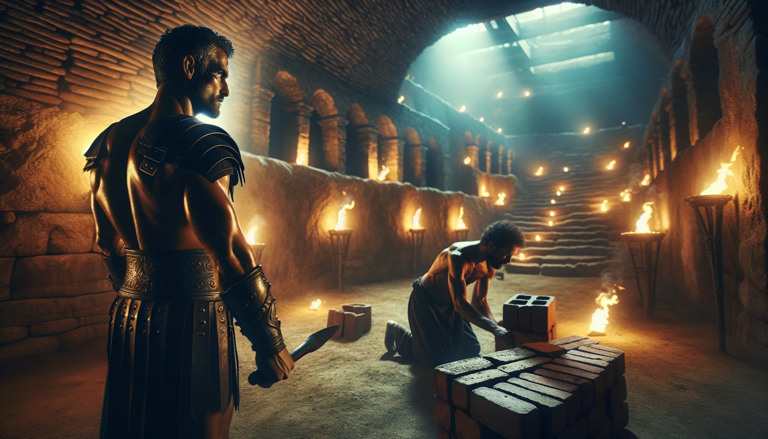In the complex world of Kings of War, building the perfect army list is a strategic art. Should you focus on reliable, consistent units that inflict steady, points-efficient damage, bricklayer-style? Or go for heavy-hitting, decisive units that can break an enemy unit in a single charge, like gladiators in the arena?
A recent post on the KOW Forums (link) sparked some discussion about points effectiveness from a damage perspective. I wanted to spend some time digging into the topic and shed some thoughts. My recent data analysis sheds light on this choice and suggests the gladiator approach has a significant edge. The difference between inflicting a few wounds and actually breaking a unit isn't linear. If you've experienced a unit whiffing a charge, only to get wiped out on the counterattack, you've encountered this dynamic firsthand. Let's look at why investing in units that act as battlefield gladiators may be the key to optimizing your list for victory.
Understanding the Gladiator and Bricklayer Concepts
The analogy of gladiators versus bricklayers in economic terms compares two distinct market dynamics. Gladiators operate in a winner-takes-all scenario where being marginally better than the opponent can lead to disproportionate rewards. In contrast, bricklayers represent a more linear relationship between effort and reward, where being slightly better only yields slight improvements.

Gladiator Approach in Kings of War
In Kings of War, the gladiator approach emphasizes units that can deliver decisive blows, eliminating enemy units in a single engagement. This strategy values units not by their steady output (as one would a bricklayer) but by their potential to alter the state of play significantly with one action. Such units can often swing the momentum of the game, providing tactical advantages and opening up opportunities for subsequent turns.
Bricklayer Approach in Kings of War
Conversely, the bricklayer approach focuses on consistency and reliability. Units that steadily perform their roles, from holding objectives to providing continuous pressure, exemplify this strategy. While not as flashy or potentially game-changing as gladiator units, bricklayers form the backbone of an army, offering stability and control.
Applying Concepts to List Building
When building an army list, players must weigh the inclusion of units with high-impact potential (gladiators) against those with reliable performance (bricklayers). However, our analysis suggests a leaning towards gladiator-type units may offer a strategic edge.
Data-Driven Insights
I conducted simulations to understand how units' chances of breaking an enemy unit correlate with their average wounds inflicted and points cost. To simplify the analysis, I pulled 50 random non-Individual, non-War Engine units with no crushing or thunderous. I then simulated a charge from that unit into a hypothetical Def 4, 13/15 unit 1,000 times and tracked the average expected wounds and the chances of breaking the opponent. My findings reveal that the relationship between wounds inflicted and the probability of breaking an enemy is not linear but polynomial. This indicates that as a unit becomes more capable of inflicting wounds, its value as a "gladiator" increases exponentially, not incrementally. To understand why this is so, think about a unit that does, on average, 1 wound to an enemy that is 13/15. It has 0% chance of breaking that enemy (1+max roll of 12 = 13). Increasing from 1 to 2 wounds similarly has no impact, and increasing from 2 to 3 increases the chances only to 1 out of 36 (if you roll boxcars). In other words, from the perspective of breaking the opponent, whether you do one wound or two doesn’t matter in a single round of combat. But each additional wound scales polynomially upwards. Going from 3 wounds to 8 wounds (a 2.67x increase in damage) has a break chance of 50%--an 18-fold increase in rout chances for a 2.67x increase in damage. In other words, if you’re valuing unit damage output from the perspective of points per wound rather than points per break chance, you’re likely to end up with a lot of bricklayers and not many gladiators.

This analysis underpins the strategic advantage of investing in units that can surpass a critical threshold of effectiveness, thus behaving more like gladiators. Units that can push beyond this threshold are disproportionately more likely to break enemy units, offering a significant return on investment in terms of battlefield impact.
For a practical example, consider my recent Undead army review. Units like Skeleton Spearmen are incredibly cost-effective on a point-per-wound basis, but they're unlikely to break an enemy unit in a single engagement. This is why the Undead faction is known for its grindy playstyle: efficient Bricklayer units attempt to wear down opponents over multiple turns. However, outside of Soul Reavers and Wights, the Undead lack a significant number of reliable Gladiator units that can consistently break enemy units in a single charge. The presence or absence of true Gladiator units significantly influences list-building decisions from the perspective of the Gladiator vs. Bricklayer framework. You can see a practical example of where this played out in a battle report at Regnum Aeternum 052 (link).

The Case for Gladiators Over Bricklayers
My dataset highlighted several units with varying points per wound and points per percentage chance of breaking an enemy. Units with lower points per % break chance effectively demonstrate the Gladiator principle: a small increase in capability (and thus cost) can dramatically increase the likelihood of breaking enemy units.
For example, consider a hypothetical unit that costs 100 points and has a 20% chance of breaking an enemy unit. If we compare this to a unit that costs 120 points but has a 40% chance of breaking the enemy, the latter unit's break chance per point is significantly higher (0.33% per point vs. 0.20% per point). This illustrates the exponential value of investing in Gladiator units that can reliably break the enemy.
On the other hand, units with a high break chance relative to their cost underscore the diminishing returns of investing in Bricklayer-type units. As units become more efficient at breaking enemies (not just inflicting wounds), their strategic value in an army list skyrockets.
This concept aligns with the advice provided by experienced players like in the Dash28 Kings of War Beginner's Guide to List Building. Dash28 emphasizes the importance of including "heavy hitters" in your army list, which can be considered analogous to the Gladiator units discussed in this article. By focusing on units that can reliably remove enemy units from the battlefield, players can create more effective and efficient army lists.
Conclusion
The distinction between gladiators and bricklayers in Kings of War list building offers a strategic lens through which players can evaluate their army composition. Our analysis suggests that focusing on units that can act as gladiators—those capable of delivering decisive, game-altering actions—can be a more effective strategy than investing in the steady, incremental advantages of bricklayer units. By prioritizing units that offer the best chance of breaking the enemy, players can construct armies that not only excel in dealing damage but also in achieving the ultimate goal: victory on the battlefield.
What are your go-to 'gladiator' units in Kings of War? Do you have any surprisingly effective picks?


